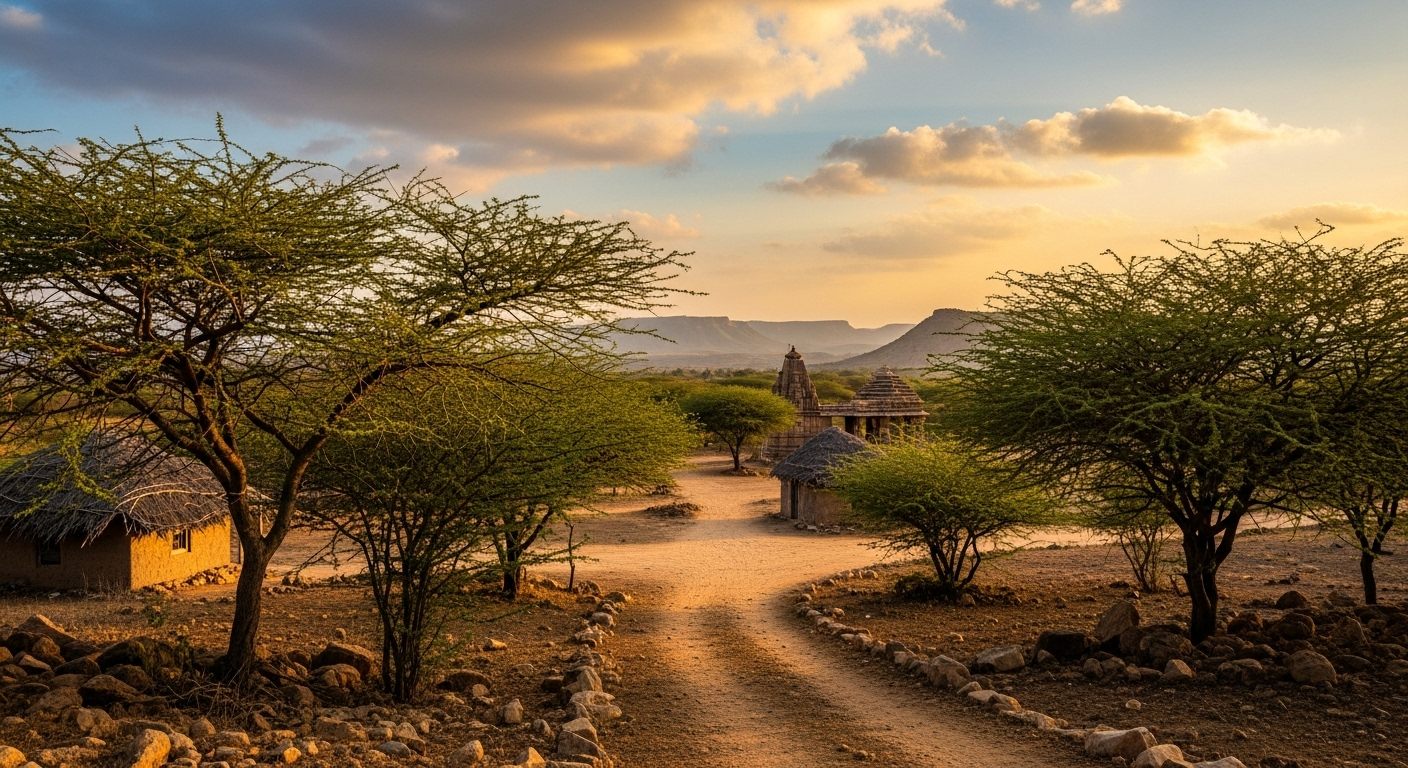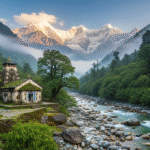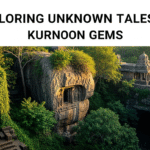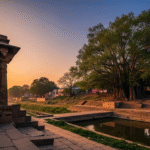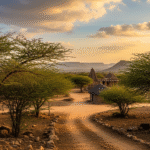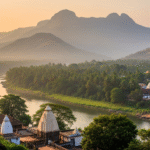Did you know Palitana’s Shatrunjaya Hill has over 3,000 temples? Yet it’s still a hidden gem in Gujarat. It’s not as famous as other places, but Gujarat has many lesser-known spots worth visiting. Places like Dholavira whisper ancient tales, while Mandvi’s beaches offer peace away from crowds. These off the beaten path destinations in Gujarat share history, culture, and nature’s beauty with you.
Gujarat hides amazing sights, like the breathtaking Gira Waterfalls in Saputara, falling 75 feet below. See Mandvi’s craftsmen create beautiful wooden ships, loved by movie makers and travelers. Or explore Vijayanagar’s wild beauty, a perfect spot to see the Dilwara Jain Temples in the Aravalli Range. These places show you the real Gujarat, far from busy tourist paths.
Key Takeaways
- The sacred Shatrunjaya Hill in Palitana is a spiritual oasis with thousands of temples.
- Saputara’s Gira Waterfalls are a natural spectacle, cascading impressively into the region.
- Dholavira offers a unique peek into the life of the ancient Indus Valley Civilization.
- Mandvi’s coastal elegance is complemented by its traditional shipbuilding heritage, famous in Indian cinema.
- The Vijay Vilas Palace boasts stunning architecture with a breath-taking coastal backdrop.
- Vijayanagar serves as a serene gateway to the majestic Mount Abu and its sacred temples.
- Gujarat’s ideal visiting months extend from March to June for the optimal exploration experience.
Champaner-Pavagadh Archaeological Park: A Glimpse Into Ancient Marvels
In Gujarat’s beautiful landscape, the Champaner-Pavagadh Archaeological Park stands proud. It shows India’s colorful history. This UNESCO site shows off ancient designs and cultures mixing over time. It’s a hidden gem for history and culture lovers.
The park includes old Champaner city and Pavagadh Hill. It’s famous for ancient temples and views. Named Gujarat’s first UNESCO site in 2004, it shows off heritage and architectural skill before the Mughal era.
Unveiling the Jama Masjid’s Architectural Splendor
The Jami Masjid in Champaner is a masterpiece. It mixes Islamic, Hindu, and Jain designs. This mosque shows the area’s rich culture mix. Built from 1484 to 1509, it took 25 years to finish. It shows a time when Champaner thrived in trade and faith.
A Walk Through History: Champaner Town and Pavagadh Hill
A visit to Champaner and Pavagadh Hill is like traveling back in time. The old temples offer a calm look at past spiritual life. The Helical Stepwell is a marvel of India’s stepwell architecture. Its spiral design is unique, showing early engineering skills from the 8th century.
In 1535, Emperor Humayun attacked Champaner during his campaign. The city had 52 markets full of traders from far away. It was a key spot for politics and economy back then.
Efforts to preserve the site today are strong. The goal is to keep it safe for the future through sustainable tourism. The best time to visit is from October to February. This time has the best weather to enjoy the site’s beauty and history.
To sum up, the Champaner-Pavagadh Archaeological Park links the past to now. It invites us to see Gujarat’s treasures hidden in time.
The Hypnotic White Desert of Rann of Kutch
Located in the western part of Gujarat, the Rann of Kutch is a breathtaking expanse. It turns into a stunning white salt desert. This geographical marvel is best seen at the Rann Utsav cultural festival. The festival lights up the desert with cultures, local crafts, and beautiful folk music. It celebrates the Rann of Kutch’s beauty and traditions, including the Bhungas huts.
The Rann of Kutch’s calm and vastness make it a unique place. It’s still not crowded with tourists. The full moon night and the quiet desert under stars offer an unmatched escape. Visit in winter, from November to February, for the best experience.
Dhordo village is perfect for adventure seekers and culture lovers. About 86 kilometers from Bhuj, it comes alive with the festival’s colors and activities. Tent City, 90 kilometers from Bhuj, offers luxury amidst the desert. It gives a unique staying experience during the festival.
| Location | Distance from Bhuj (km) | Attraction |
|---|---|---|
| Dhordo Village | 86 | Gateway to Rann Utsav |
| Kalo Dungar | 45 | Highest point in Kutch, grand panoramic views |
| Dholavira | 250 | Insight into Indus Valley Civilization |
Exploring the Rann of Kutch is more than seeing its beauty. It connects visitors with nature and India’s history. This undisturbed spot shows the local culture’s resilience and creativity, especially during Rann Utsav. The journey shows a natural wonder that links Gujarat with Pakistan’s Sindh, admired by everyone who visits.
Discovering the Textile Treasure Trove of Patan
Patan is in the heart of Gujarat. It’s known for history, crafts, and textiles. The city was the capital for 650 years. It is famous for Patola silk sarees, known for luxury and skill. These sarees have vibrant colors and same patterns on both sides. They are made by a technique called double ikat dyeing.
Traditional Artistry: Patola Silk Sarees
Only three Salvi families know how to make Patola silk sarees in Patan. Making one saree takes four months to a year. This shows their hard work and dedication to their craft. The sarees have detailed patterns that take a long time to make.
There’s a place in Patan called the Patan Patola Heritage Museum. Here, you can learn about these special textiles. The museum shows off not just Patola sarees but other traditional Gujarati crafts too.
A Stepwell Like No Other: Rani Ki Vav’s Elegance
Rani Ki Vav is very special and part of the World Heritage List since 2014. Queen Udayamati built it in 1060 to remember her husband. It was hidden under silt for years but then found and fixed. This stepwell tells stories through its amazing sculptures.
Now, Rani Ki Vav is a big deal for history and architecture lovers. Its beauty and design marvel those who visit. The stepwell shows the smart building skills of the past.
Pilgrimage and Panoramas: The Sacred Ambiance of Palitana
Palitana in Gujarat hides a treasure. The Shatrunjaya hill is home to many sacred temples. These sites draw visitors with their beauty and peacefulness.
Getting to the temples takes effort. You must climb 3,000 steps to see over 900 temples. This journey is hard but very rewarding. The views and spirituality lift your spirits.
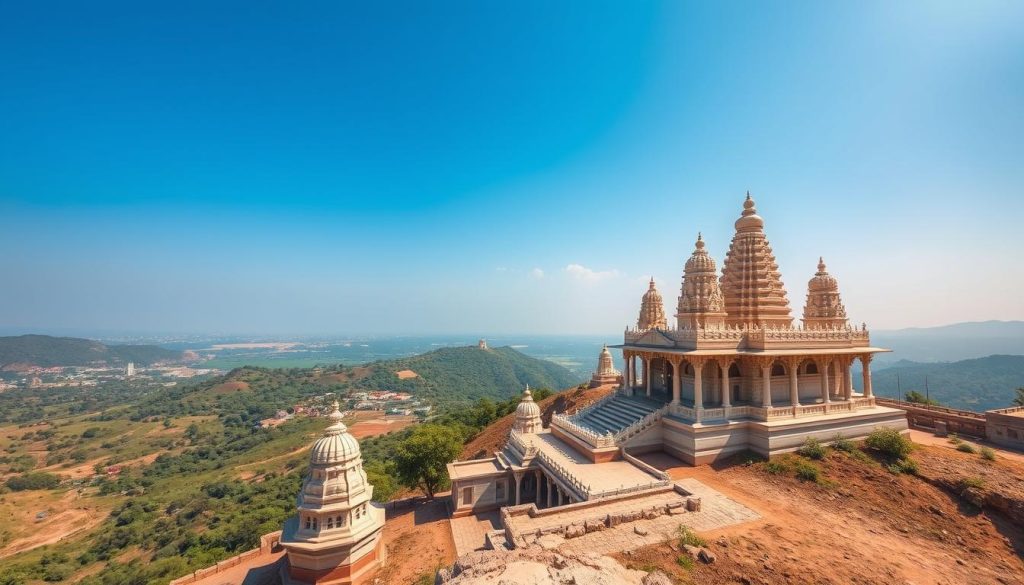
Around the hill, there is peace and deep Jain tradition. Palitana is known for being strictly vegetarian. This shows their commitment to non-violence, a key Jain belief.
Ascending the Spiritual Summit: The Shatrunjaya Hill Temples
Climbing Shatrunjaya Hill changes you. Every step brings you closer to the divine. These old temples are beautiful and full of history. They embody Jainism’s spirit.
Preserving Purity: Vegetarianism in Palitana
Palitana keeps a vegetarian rule to stay pure for spiritual growth. This clean living helps make Palitana special among Jain sacred places.
Palitana is easy to reach by air, train, or road. Its location makes it a key spot for those seeking a spiritual trip. Or for anyone wanting peace in ancient sites.
Palitana is not just for spiritual journeys. Its area has rich culture and nature. There’s Gopnath Beach and Blackbuck National Park. These places show Gujarat’s heritage and natural beauty.
Serene Escapes in Saputara: Gujarat’s Only Hill Station
In Gujarat’s Dang district, Saputara hill station stands out. It’s a peaceful place far from the busy city. It’s the only hill station in Gujarat, offering a nature-filled getaway.
Adventure lovers will find the area around Saputara great for hiking. Places like Ahwa have thick forests perfect for treks. Waghai is wonderful for people who love birds. Near the amazing Gira Waterfalls, birds gather in large numbers.
Purna and Don are other must-visit spots near Saputara. Purna has the historic Lord Ambika Temple. Don is famous for Warli art and beautiful views along the Ambika River.
Saputara’s charm comes from its rich nature and Saputara Lake. The lake is ideal for boating and picnics, surrounded by green hills. It’s a true paradise for nature lovers. Despite its beauty, the area is still quiet and perfect for a peaceful time. Visitors can enjoy activities like paragliding and ziplining.
Getting to Saputara is easy, thanks to nearby Surat airport and Bilimora railway station. This special place remains untouched by heavy tourism. It keeps its peaceful charm.
| Location | Distance from Major Transport Hubs | Key Attractions |
|---|---|---|
| Saputara | Surat Airport – 167 km Bilimora Railway Station – 50 km | Saputara Lake, Gira Waterfalls |
| Don | Waghai Railway Station – 61 km | Ambika River, Warli Art |
| Waghai | Surat Airport – 153 km | Gira Waterfalls, Bird Watching |
| Ahwa | Surat Airport – 160 km | Trekking, Dense Forests |
Saputara hill station combines adventure and peace beautifully. It’s perfect for anyone who wants to explore quieter parts of Gujarat.
Uncovering the Historical Layers of Bhuj
Stepping into Bhuj is like going through a maze of culture, history, and tradition. It’s one of Gujarat’s hidden spots to visit. With its rich history and beautiful sights, Bhuj welcomes travelers. They can explore places like the Aina Mahal Palace of Mirrors and the bright Kutch culture.
The Royal Reflections of Aina Mahal
In Bhuj, the Aina Mahal Palace of Mirrors stands proudly. This 18th-century beauty shows amazing craftsmanship and design. It mixes Indian and European styles. Inside, the hall of mirrors dazzles with reflective glass and colorful murals. It feels like stepping into a royal past. This palace makes Bhuj a must-visit in Gujarat.
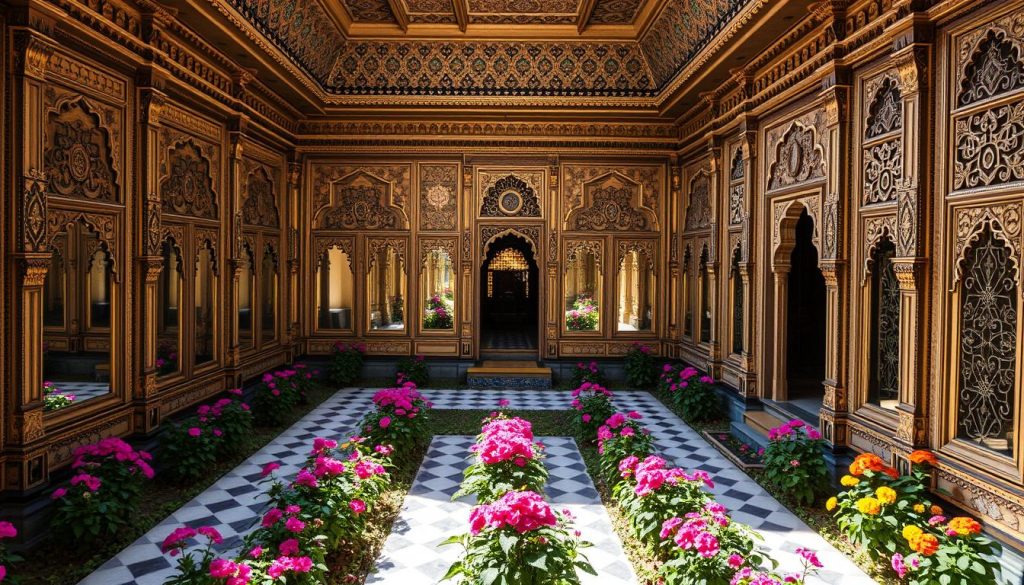
Witnessing Kutchi Culture Through Tribal Artisan Villages
Beyond the Aina Mahal, Bhuj reveals the Kutch culture through its tribal villages. These places buzz with traditional art like embroidery, pottery, and weaving. Skills have been handed down for generations. Every village tells its own story through its crafts. This connects visitors deeply with Kutch’s cultural roots.
Bhuj’s charm also shines through its weather and geography. Let’s look at some facts:
| Feature | Description |
|---|---|
| Climate | Winter temperatures are cozy, perfect for exploring. But summers can get hot, so mornings and evenings are best for visits. |
| Topography | Kalo Dungar gives a stunning view from high above the desert. It’s the top spot in Kutch. |
| Wildlife Reserve | The vast Wild Ass Sanctuary is home to unique wildlife. It spreads over a big area. |
| Festivals | The Rann Utsav celebrates local culture with performances and crafts. It happens from November to February. |
These features help make Bhuj a wonderful place for all. It’s great for regular tourists and those who love culture, visiting Gujarat.
Dholavira: Journey to an Ancient Indus Valley Civilization Site
Discover Dholavira, a significant archaeological site in Gujarat, India. It showcases the smart building and planning skills of the ancient Indus Valley Civilization. Compared to other sites, it stands out for its stone, not brick, constructions.
This UNESCO World Heritage Site, named “Dholavira: A Harappan City,” takes you back in time. It has a smart layout with a Citadel, middle town, and lower town. It also shows early efforts in saving water, a highlight for visitors.
The meticulous excavation of Dholavira not only uncovers the city’s physical structure but also its societal organization and culture, reflecting the sophistication of the Harappan era.
Excavations in Dholavira revealed many water reservoirs made from stone. They used the ground’s natural slope for water management. The city’s cemetery, with unique burial shapes, gives us a peek into their culture.
| Feature | Description |
|---|---|
| Size of Settlement | 100 hectares, equivalent to 140 soccer pitches |
| Water Conservation | Earliest form of water management systems with 16+ reservoirs |
| Architectural Form | Fortified citadel, middle and lower towns with unique stone construction |
| Excavation Periods | 1990-2005, focused on revealing urban planning and architectural insights |
| UNESCO Status | Designated in 2021 under “Dholavira: A Harappan City” |
Visiting Dholavira lets you see the ancient world’s complexity. It highlights the advanced skills of the Indus Valley Civilization. This site connects us to our past, showing our ancestors’ cleverness.
Mandvi’s Coastal Charms: From Pristine Beaches to Shipbuilding Yards
Mandvi is a beautiful town in Gujarat. It is known for its lovely beaches and shipbuilding heritage. Tourists love its peaceful vibe and rich history. This makes Mandvi a hidden gem in Gujarat. It was once a busy port city. Today, it keeps its old-world charm and historical value.
Royal Resplendence at Vijay Vilas Palace
Vijay Vilas Palace shows off amazing architecture. It blends styles from Kutch, Rajasthan, and Bengal. People who visit are wowed by it. The palace highlights Mandvi’s rich culture. Its big gardens and balconies offer stunning views of Mandvi Beach. This shows how nature and architecture come together beautifully in Mandvi.
The Artistic Craftsmanship of Mandvi’s Shipbuilders
Mandvi’s shipyards are full of life. Here, craftsmen build incredible wooden ships using old techniques. This shipbuilding is special to Mandvi’s history. It shows how important the town was by the sea. The workers’ skills keep an important part of local culture alive. Visitors find this look into old Gujarat crafts fascinating.
Lesser-known Places in Gujarat: Vijayanagar and its Hidden Wonders
In the beautiful Aravalli Range, there’s Vijayanagar. It’s peaceful and full of nature’s beauty. It’s close to Mount Abu, making it a great spot for adventures. This place is truly a hidden gem in Gujarat.
Vijayanagar is known for more than its views. It has the Nakki Lake legends. These stories attract those who love nature and tales. The folklore makes the lake mysterious, perfect for lovers of stories and beauty.
Vijayanagar is rich in culture too. It has important but not well-known heritage sites. These sites add to Vijayanagar’s charm. Let’s look at some key places:
| Site | Description | Historical Significance |
|---|---|---|
| Polo Forest | A verdant forest reserve | Not just a natural retreat but an echo of the past with remnants of ancient civilizations |
| Rani Hindola | Known battle site | Rumored hiding spot of Maharana Pratap during the battle of Haldi Ghati |
| Veeranjali Van | Tribute site in PAL village | Commemorates 1200 martyrs of a 1942 firing incident, highlighting the tribal contribution to India’s freedom struggle |
| Rukhda Tree | Ancient tree in Vijaynagar | A symbol of endurance, being over 150 years old and one of the rare 15 left in India |
Vijayanagar combines history, culture, and beauty. It’s a must-see for travelers and history lovers. The quiet, spiritual Nakki Lake and Vijayanagar’s history make it special. It’s not just a peaceful spot but a place rich with legends and traditions. It shows the many sides of Gujarat.
Conclusion
Gujarat is full of places waiting to be discovered. It offers many chances for fun travel adventures. The enchanting Champaner-Pavagadh Archaeological Park, the vast white Rann of Kutch, and the peaceful Saputara hills show Gujarat’s unique beauty. From Bhuj’s rich culture to the long, serene beaches, Gujarat has much to offer.
Every corner of Gujarat holds a surprise. You might find an ancient Sun God temple in Modhera. Or discover the quiet and beautiful Narara Island. These places show how Gujarat has something special everywhere.
Nature lovers can enjoy the bright Ninai Waterfall. Or try fun activities near Nadabet. This place offers ATV rides and bird watching. You might even see pink flamingos in the sky. The Navlakha temple in Ghumli and another same-named temple show the strong spiritual side of Gujarat. They’re part of Gujarat’s rich history.
Exploring Gujarat isn’t complete without its festivals. The Rann Utsav festival is full of art, crafts, and local life. Gujarat’s food, like Dhokla and Thepla, makes the experience even better. Every moment here becomes a memory to keep. For those who love exploring, Gujarat offers nature, history, spirituality, and tradition. It truly is a journey into the heart of India’s cultural dynamism.
FAQ
What is special about the Champaner-Pavagadh Archaeological Park?
The Champaner-Pavagadh Archaeological Park is a UNESCO site full of history and beauty. It covers the old town of Champaner and Pavagadh hill. This place has temples, mosques, and stepwells from the past.
Can you describe the experience of visiting the Rann of Kutch during the Rann Utsav festival?
The Rann Utsav makes the Rann of Kutch a magical white desert. You stay in traditional Bhungas and enjoy local arts and crafts. At night, the desert glows beautifully under the moon.
What makes Patan a significant destination for textile enthusiasts?
Patan is famous for its Patola silk sarees, made with a special dyeing method. The Salvi family keeps this tradition alive. Patan is also known for the Rani Ki Vav stepwell and its art, making it a must-visit for textile lovers.
Why is Palitana an important destination for spiritual travelers?
Palitana has over 3,000 temples on Shatrunjaya hill, a key site for Jain pilgrims. Climbing the hill’s 3,000 steps brings you to a sacred place with amazing views. The city’s commitment to vegetarianism adds to its spiritual atmosphere.
What attractions does Saputara offer as Gujarat’s only hill station?
Saputara, nestled in the Dang forest, is Gujarat’s unique hill station. It’s filled with greenery and calming sites like Saputara Lake. Visit Gira Waterfalls for a peaceful escape into nature.
What historical and cultural experiences can one find in Bhuj?
Bhuj brings Kutch culture to life with places like Aina Mahal. This palace shows off amazing architecture and art. Visiting local Kutch villages, you’ll see unique traditions and textiles, making Bhuj a hidden gem in Gujarat.
What is significant about Dholavira and its connection to the Indus Valley Civilization?
Dholavira offers a peek into the advanced Indus Valley Civilization. It has incredible urban designs, water systems, and ancient scripts. This site holds major historical and archaeological value for those exploring ancient cultures in Gujarat.
What unique experiences does Mandvi offer visitors to Gujarat?
Mandvi offers a beautiful beachside and the craft of wooden shipbuilding. The Vijay Vilas Palace showcases grand architecture. This town shares Gujarat’s maritime heritage and royal history as one of its secrets.
How does Vijayanagar cater to travelers looking for quieter, lesser-known attractions?
Vijayanagar lies in the Aravalli Range, close to Mount Abu and the Dilwara Jain Temples. Nakki Lake adds charm with peaceful boating and stories. It’s a quiet spot for those seeking beauty and calm in Gujarat.
